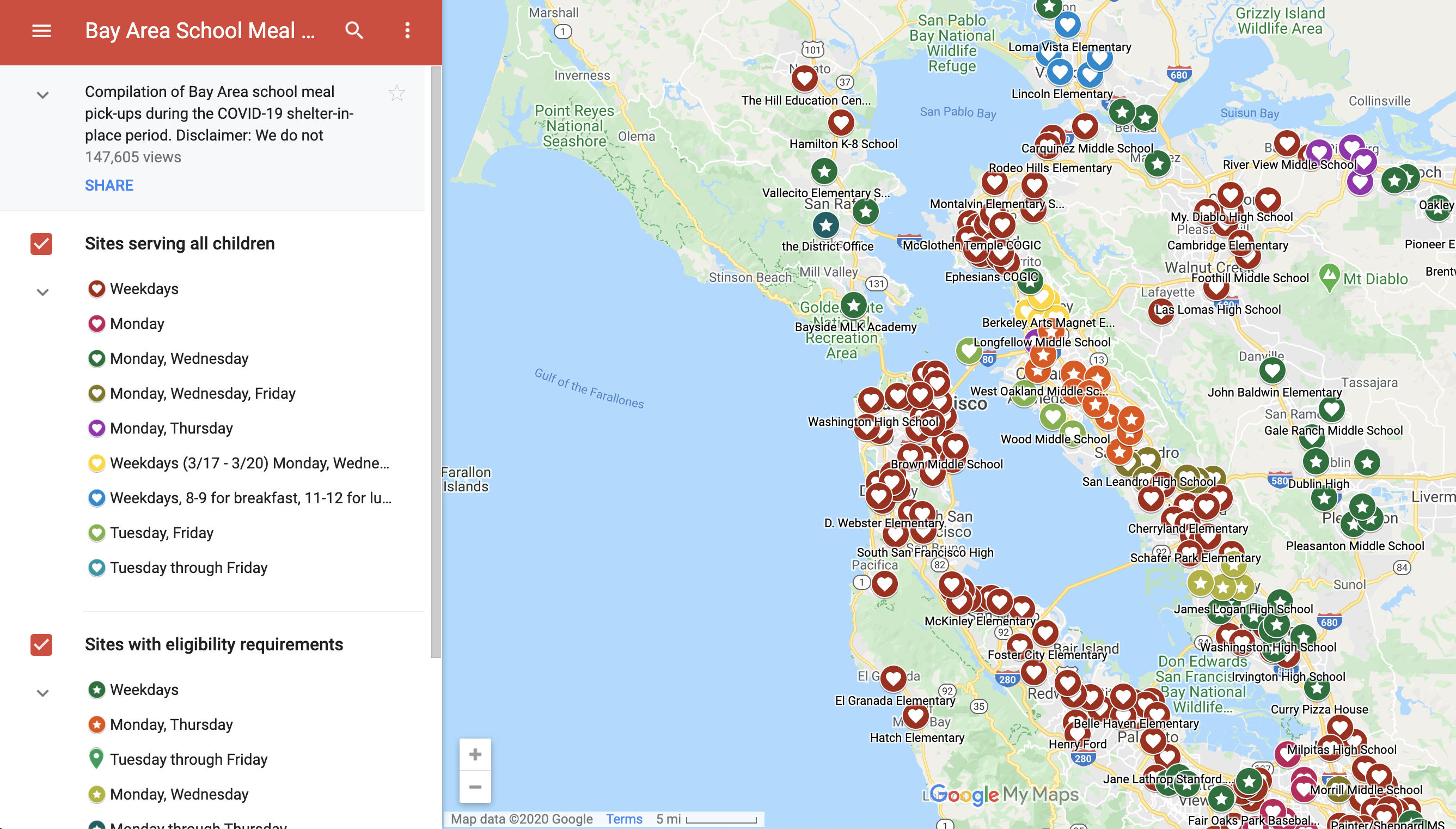A team of undergraduate and graduate students has created a digital map detailing where Bay Area children can still find free meals in the wake of school closures that have upended plans for students who rely on free and reduced-price lunches.
As of Saturday, the site lists 471 locations, including some serving students from specific districts and some offering food for anyone under the age of 18. Each listing includes information about eligibility requirements, the sorts of food offered, hours of operation and contact information.
Stanford’s Big Local News Program — a project that collects complex government information — aided in compiling the list of locations along with help from nearby school districts, nonprofits such as Second Harvest and news agencies.
The team maintaining the site consists of a mix of graduate and undergraduate students studying epidemiology, public policy, communication and economics, among other fields. Most of the team met through the course ENGR 150: “Data Challenge Lab,” in which students use data in real-world applications, such as analyzing voter behavior and tracking climate change. The course has since been defunded and discontinued.
Last Monday, journalism masters student Amy DiPierro M.A. ’20 put the group in touch with computational journalist and Big Local News Director Cheryl Phillips.
“We were on a call with them, and they were talking about school lunch programs and how it would be really interesting if we could put together some sort of accumulation of food banks, school lunch programs, resources people could reach out to during this closure, and then [Big Local News] would push it out on local media,” said Chris LeBoa ’19 M.S. ’20, one of the team members. “It just takes a couple hours of going onto different websites, different Facebook feeds. And so that’s how it came to be.”
The site went live the next day with information on five Bay Area counties. The day after that, the team broadened to include 12 Bay Area counties.
Each of the six team members is assigned to check in with sites and update their locations. For example, LeBoa updates all San Mateo County and Santa Clara County sites.
At first, each site was updated daily as the distribution centers adapted to turbulent environments.
“School districts are being battered with updates every day and need to update their students and parents and communities every day,” said Charlie Hoffs ’22, another team member. “As this crisis deepened, part of me was wondering, ‘Are all these school meal programs going to have to close down?’ They don’t have funding to run school meals over spring break. I was worried that all these programs would start folding due to lack of staff, health concerns or logistics, but what we’re seeing is just unilateral expansion across all these programs.”
Meals will continue to be provided at schools in seven Bay Area counties throughout the closure, according to a press release from Wednesday.
Now that the sites have settled into a routine, locations are updated once a week.
One question troubling the team is just how effective its service is. According to Google Analytics, the website has more than 108,000 views since its Tuesday launch, but the team does not know how many people actively use this information and visit food distribution centers as a result.
“People are looking at the map, but are the most vulnerable communities accessing the map and using it to find places where they can get free food? We’re not sure,” Hoffs said. “If not, maybe we need to critically address other issues.”
The team is now looking into a few projects to improve its service. For one, it is considering expanding to cover the Sacramento suburbs, more of California and possibly Oregon, but team members fear that this could impact data accountability and keep the group from deepening its work in the local community.
“It’s really about how long you want to keep something up and have accountability to do a project over time,” LeBoa said. “We don’t want to have any person in charge of more than a couple counties. We want to be really cognizant of our own data.”
The team is working on improving its communication by looking into Twilio, a system for text message alerts.
“One of the folks we were working with was telling us about how people have more access to phones than computers, an SMS text message might reach people more easily than a Google Maps website,” Hoffs said. “Perhaps you get a notification in the morning of five school sites distributing meals from noon to 1 p.m. within a five mile radius of you.”
The group is also hoping to translate into other languages to increase accessibility.
“We’re not sure what our next move is, but we’re excited and there’s a lot of need and a lot of opportunity to do meaningful work,” Hoffs said.
Contact Sonja Hansen at smhansen ‘at’ stanford.edu.
